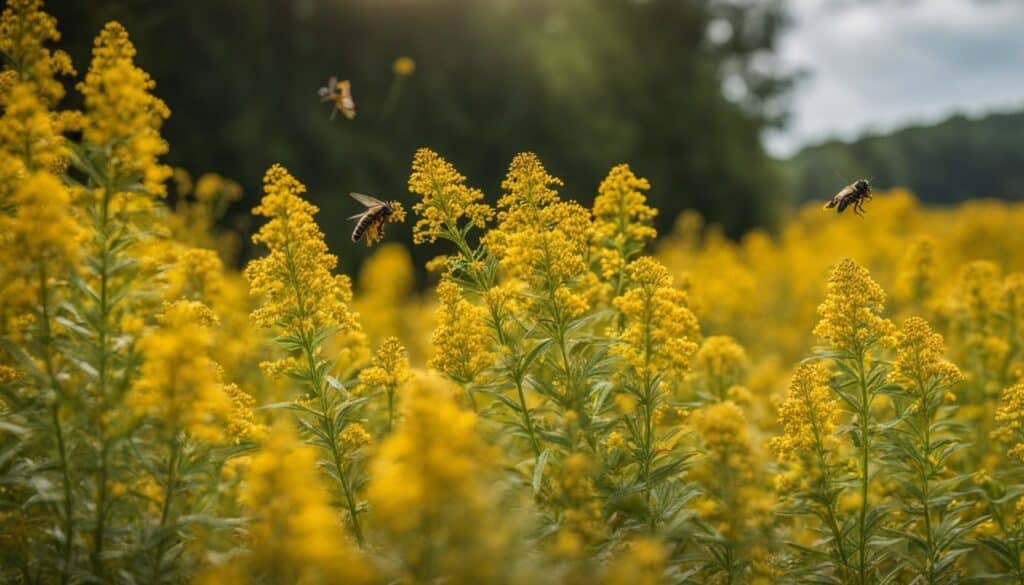The Ultimate Guide To Goldenrod: Benefits, Uses, And Cultivation

Are you looking for a vibrant addition to your garden with many benefits? With its bright yellow blooms, Goldenrod isn’t just pretty—it’s packed with medicinal properties that have been recognized for centuries.
This guide will unveil how goldenrod can enhance your health and garden, from cultivation tips to its therapeutic uses. Discover the golden touch of this underrated wildflower.
Key Takeaways
- Goldenrod is a bright yellow plant that is good for your garden and health. It’s not ragweed, so it won’t make allergies worse.
- You can grow goldenrod in full sun or light shade. It is like soil that drains well. Cut the plants back in spring to make them grow more flowers.
- There are many kinds of goldenrod. They have been used as medicine for a long time to help with kidney problems and colds.
- When growing goldenrod, divide the plants every few years to keep them from spreading too much. Cut off old flowers to get more new ones.
- Planting goldenrod can help stop ragweed from growing in your garden because they compete with each other.
Description and Taxonomy of Goldenrod

Goldenrod, a member of the Asteraceae family, is often mistaken for ragweed due to its late summer bloom and yellow flowers. However, goldenrod does not produce pollen that causes hay fever, making it an important plant for pollinators and ecosystems.
Its evolutionary relationships within the Solidago genus highlight its ecological and cultural significance.
Goldenrod vs. Ragweed
Understanding the differences between goldenrod and ragweed is essential for anyone interested in botany, gardening, or health improvement. While both plants are often found in similar environments and bloom around the same time, they are distinct in several ways. Here is a comparison outlined in an HTML table format:
| Characteristic | Goldenrod (Solidago spp.) | Ragweed (Ambrosia spp.) |
| Taxonomy | Belongs to the Asteraceae family. | Also a member of the Asteraceae family but a different genus. |
| Pollen | Has heavier, stickier pollen adapted for insect pollination. | Produces lightweight pollen that easily disperses in the air, often causing allergies. |
| Flower Type | Showy, yellow flowers that attract pollinators. | Small, inconspicuous green flowers that often go unnoticed. |
| Leaves | Features variously shaped leaves depending on the species. | Typically has finely divided leaves, resembling a fern. |
| Medicinal Uses | Regarded for its potential health benefits and used in traditional medicine. | Lacks medicinal properties and is not used for health purposes. |
| Allergenicity | Often erroneously blamed but is not responsible for hay fever. | Known as a primary culprit for seasonal allergies due to its airborne pollen. |
| Cultural Significance | Considered a beneficial wildflower with ecological value. | Viewed unfavorably due to its association with allergies. |
This table breaks down key differences between these two plants, clarifying how they affect the environment and human health. Remember, ragweed is the plant to watch out for if you suffer from seasonal allergies, not the beneficial goldenrod.
Evolutionary Relationships within Solidago
Goldenrods, or Solidago, are part of a big family of plants with many different kinds. Scientists have studied how these plants are related to each other. In 1993, a man named Nesom made a system to show how all the types of goldenrod fit into groups based on their family tree.
This helps us see which goldenrods are more like cousins and which are more distant relatives.
This plant group has undergone many changes to become the species we know today. They show us how nature can make new kinds from old ones because they live in many places and adapt to where they grow.
The evolutionary story of Solidago is filled with twists as it branched out into so many species that look pretty and help our health by being around us.
Ecology and Cultural Significance
Goldenrod plants are key players in North America’s pollinator world. They help insects like butterflies and bees by giving them nectar. This makes goldenrods very important for keeping these bugs around, which also helps other plants and the environment.
People have seen this and often plant goldenrod in butterfly gardens or natural areas to give these helpful insects a place to get food and stay safe.
These bright yellow flowers also mean a lot in American history. Native Americans used goldenrod for health and healing long ago. Some people still use it for tea or as an herb that can make them feel better when sick.
Because it is part of the land’s history, many gardeners grow native plants like goldenrod in their yards or vegetable gardens. It shows they care about where they live and want to keep the traditions alive.
Growing and Caring for Goldenrod

Providing the plant with full sun and well-drained soil is important to successfully grow goldenrod. Regular watering and occasional fertilizing can help maintain its health, while pruning in early spring will encourage bushier growth and more robust flower production.
Light, Soil, Water, Temperature, and Humidity Requirements
Goldenrod thrives in full sun to light shade and well-drained soil. It does well in lean soil conditions and typically does not require fertilizing. The plants thrive in just about any average garden soil with decent drainage, including heavy clay, sandy, or rocky soil.
- Seaside goldenrod may benefit from nurse crops that lower temperature and increase moisture.
- Cold stratification and a light source can break dormancy and promote growth in seaside goldenrod.
- Goldenrod plants have average moisture preferences and do not like overly moist or dry soils.
- Mulching around goldenrod plants helps retain moisture, suppress weeds, and regulate soil temperature.
Fertilizing and Pruning Tips
To ensure healthy growth and vibrant blooms, follow these tips for fertilizing and pruning goldenrod:
- Fertilizing Frequency: Goldenrod benefits from annual fertilizer application. However, avoid overfeeding, leading to floppy growth and fewer flowers.
- Pruning Stem Tips: Pruning the stem tips early in the season can result in fuller and bushier plants with more flowers later in the season.
- Optimal Pruning Times: Consider pruning goldenrod at specific times for optimal growth and care.
- Watering Importance: Ensure consistent watering as it is essential for the healthy development of goldenrod plants.
- Supplemental Fertilizer: Goldenrod can grow without supplemental fertilizer, but if needed, consider adding it sparingly to support healthy growth without causing overfeeding issues.
- Careful Fertilizer Application: When fertilizing solidago, be mindful of the amount used to avoid potential negative effects on growth.
- Balanced Soil Nutrition: Provide balanced nutrition through soil amendments to prevent excessive reliance on supplemental fertilizers.
- Avoiding Floppy Growth: Overfeeding may lead to floppy growth; therefore, monitor fertilizer use closely to maintain plant health.
Propagation Methods
Goldenrod can easily be propagated in a few ways, making it accessible for home gardeners. Here’s how you can do it:
- Division: Divide the plant in the spring by cutting its stalks back to a few inches above ground level. This promotes new growth and allows you to create multiple plants from one.
- Seed Propagation: Goldenrod can also be propagated from seeds, making it an easy option for cultivation. Sow the seeds directly outdoors in the fall or spring, or start them indoors for more controlled conditions.
- Seaside Goldenrod Specifics: If propagating seaside goldenrod, adhere to specific planting guidelines. It may be done through seed or division methods.
- Taking Cuttings: Another common method is taking cuttings from existing plants to grow new ones. This provides a quicker way to expand your goldenrod population.
- Ease of Growing: Goldenrod is extremely easy to grow from seed, requiring minimal effort and expertise on the gardener’s part.
Uses and Diversity of Goldenrod
Goldenrod has many uses, from ornamental and industrial to traditional and medicinal. It is also an essential plant for pollinator insects and migrating butterflies and bees.
To discover more about the diverse uses of goldenrod, keep reading!
Ornamental and Industrial Uses
Goldenrod is not just a hardy, beautiful addition to your garden; it also serves ornamental and industrial purposes. Its bright yellow flowers make it a popular choice for floral arrangements, adding a vibrant touch to any space.
Moreover, goldenrod has been historically used as a natural dye for textiles, creating rich and warm hues that can be utilized in various industrial applications. This versatile plant brings both visual appeal and practical uses to the table.
It’s important to note that the flowering tops of goldenrod have been traditionally used as an ingredient in herbal medicine due to their potential healing properties. Additionally, its diuretic effects have been recognized since ancient times.
Traditional and Medicinal Uses
For centuries, goldenrod has been a staple in folk medicine, renowned for its diverse medicinal uses. It is traditionally employed to address urinary tract infections and promote kidney health.
In German folk medicine, goldenrod alleviates urinary retention, treats kidney stones, and manages hemorrhoids. These traditional uses highlight the plant’s significance in supporting overall urinary system wellness.
Goldenrod has long been used as an herbal remedy with several potential health benefits. It’s worth noting that scientific research supports some of these traditional uses. For example, studies indicate that goldenrod possesses anti-inflammatory properties and may positively impact urinary health.
Accepted Species and Natural Hybrids
Goldenrod’s vast array of species and natural hybrids offers a wealth of diversity for both ecological contribution and human health benefits. These plants, belonging to the Solidago genus, have evolved, creating various varieties that suit different environments and purposes. Below is a table showcasing a selection of accepted species and their noteworthy hybrids that reflect this genus’s adaptability and usefulness.
| Species Name | Description | Health Benefits | Native Region |
| Solidago canadensis | Commonly known as Canada goldenrod, this species is recognized for its tall stature and vibrant yellow flowers. | Traditionally used for inflammation and urinary tract issues. | North America |
| Solidago virgaurea | European goldenrod, it features smaller flower clusters and is widely used in herbal remedies. | Known for its diuretic properties and kidney stone prevention. | Europe |
| Solidago gigantea | Giant goldenrod is aptly named for its tall growth; it also tolerates various soil conditions. | Effective in treating seasonal allergies and promoting wound healing. | North America |
| Solidago altissima | Also known as tall goldenrod, it’s distinguished by its height and abundant flowering. | Used to alleviate symptoms of colds and flu. | North America |
| Solidago x luteus | A hybrid of S. canadensis and S. virgaurea, combining traits of both parents. | Incorporates the medicinal benefits of its parent species. | Hybrid Origin |
The table reflects only a handful of the numerous goldenrod species and hybrids. Enthusiasts cultivate these varieties in gardens or use them in health-focused products, showcasing the plant’s versatility. Solidago’s ability to adapt and flourish in diverse locales mirrors its capability to foster well-being.
Common Problems with Goldenrod and How to Solve Them
Some common problems with goldenrod include aggressive spreading and leggy growth. To solve these issues, regular pruning and dividing the plants every two or three years can help manage their growth and maintain a more compact shape.
Additionally, deadheading spent flowerheads can encourage more blooms and prevent self-seeding.
Aggressive Spreading and Leggy Growth
Goldenrods are known for their aggressive spreading due to their underground rhizomes. This can make them seem weedy in certain areas. Proper care and maintenance techniques can help address concerns about the leggy growth of goldenrod.
- Goldenrods have a rhizomatous growth habit, allowing them to spread aggressively through underground rhizomes.
- This rapidly spreading nature can lead to concerns about their appearance in garden settings and natural landscapes.
- To manage this aggressive growth, gardeners may consider planting less aggressive species or limiting goldenrods using barriers such as edging or containers.
- Regularly dividing and replanting goldenrod clumps every two or three years can help control their spread and rejuvenate the plants.
- Leggy growth, characterized by tall, spindly stems, may occur due to insufficient sunlight or overcrowding.
- Adequate sunlight, proper spacing between plants, and providing support in stakes or lattices can help prevent leggy growth and promote more compact, bushy plants.
- Pruning back taller stems and deadheading spent flower heads can encourage bushier growth and more prolific flowering.
Encouraging More Blooms and Deadheading Techniques
To encourage more blooms and keep your goldenrod plants healthy, try these techniques:
- Deadhead spent flower heads: Removing the old flower heads can help prolong the blooming season of your goldenrod well into the fall. This also prevents the plant from using its energy to produce seeds, encouraging it to produce more flowers.
- Regular pruning: Pruning your goldenrod regularly is essential to prevent the plants from becoming too leggy. Aim to cut back about one-third of the plant in late spring or early summer to encourage bushier growth and more blooms.
- Prevent problems: Deadheading can also help prevent common issues associated with goldenrods, such as aggressive spreading and overcrowding, ensuring a healthier and more attractive garden.
- Maintenance is key: Keep an eye on your goldenrod throughout the blooming season, removing faded flowers as soon as they start to decline to maintain a neat appearance and promote continuous flowering.
- Boosting biodiversity: By deadheading spent flower heads, you can attract more butterflies and pollinators to your garden while preventing self-seeding that can lead to invasive tendencies in some species.
Control of Ragweed Around Goldenrod Plants
Enlisting native goldenrod plants can help control ragweed, a common culprit for hay fever.
- Planting goldenrod near or around your garden can outcompete ragweed, limiting its growth and spread.
- Inspect the area for any signs of ragweed and promptly remove any sprouts to prevent further proliferation.
- Consider using natural mulches like wood chips or straw to suppress ragweed growth while promoting goldenrod’s development.
- Introduce natural competitors of ragweed, such as native grasses or wildflowers, to create a biodiverse environment that discourages the growth of ragweed.
- Encourage birds and beneficial insects that feed on ragweed seeds by providing suitable habitats like bird feeders and insect-friendly plants.
FAQs
Q: What are the benefits of growing goldenrod?
A: Goldenrod is a native plant that offers many benefits, including attracting pollinators, providing food and habitat for wildlife, and offering a striking addition to gardens and natural landscapes.
Q: What are some common names for goldenrod?
A: Goldenrod is known by various common names, including solidago, flat-topped goldenrod, white goldenrod, and rough goldenrod, depending on the species and cultivar.
Q: How should I care for goldenrod in my garden?
A: Goldenrod care involves planting it in well-drained soil, providing adequate sunlight, and ensuring regular watering, especially during the initial growth phase. Also, deadheading spent blooms can encourage new growth.
Q: What is the best way to cultivate goldenrod?
A: Goldenrod is best cultivated as a perennial; depending on the species, it may require different care. Understanding the specific needs of the goldenrod species you cultivate is essential to ensure successful growth.
Q: What are some tips for gardening with goldenrod?
A: When gardening with Goldenrod, consider choosing native species, creating mixed plantings to support a diverse ecosystem, and aligning the garden design with the natural habitat of the Goldenrod for optimal growth and aesthetic appeal.
Q: Can goldenrod be mistaken for ragweed?
A: While goldenrod is sometimes mistaken for ragweed, it is essential to note that goldenrod blooms with bright yellow flowers and is not responsible for causing hay fever, unlike ragweed, which produces pollen that triggers allergic reactions.
Q: What are some notable institutions involved in the study of goldenrod?
A: Notable institutions, such as the Missouri Botanical Garden and Harvard University Herbaria, have been actively involved in the study, conservation, and documentation of different species of goldenrod, contributing to our understanding of this diverse genus.
Q: How does goldenrod contribute to the flora of North America?
A: Goldenrod plays an essential role in the flora of North America, with many species being native to the region and contributing to the ecological balance and biodiversity of various ecosystems, from woodlands to meadows.
Q: What are some misconceptions about goldenrod?
A: Goldenrod is often erroneously blamed for hay fever, while the wind-pollinated ragweed causes allergic reactions. Additionally, certain species of goldenrod are unfairly considered weeds, overlooking their ecological and aesthetic value.
Q: What are some different species of goldenrod?
A: Goldenrod encompasses a diverse range of species, including Euthamia, Solidago, and different cultivars, each with distinct characteristics, blooming patterns, and ecological roles within their respective habitats.

